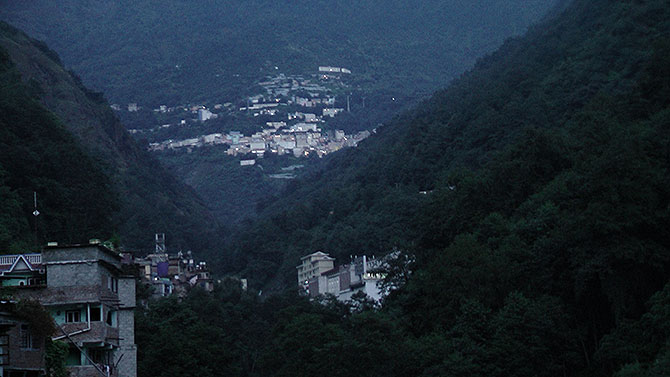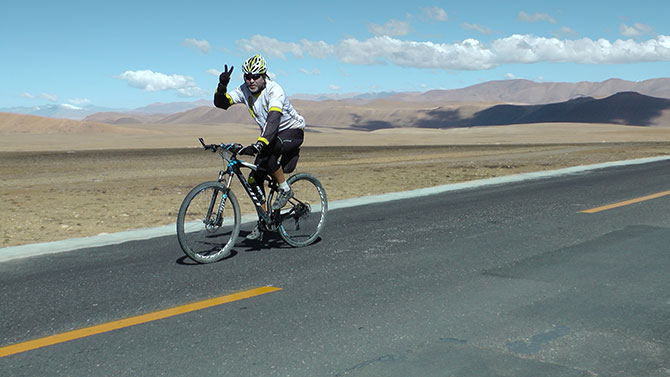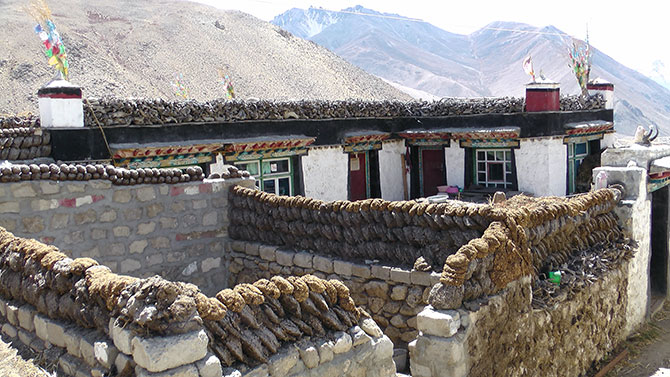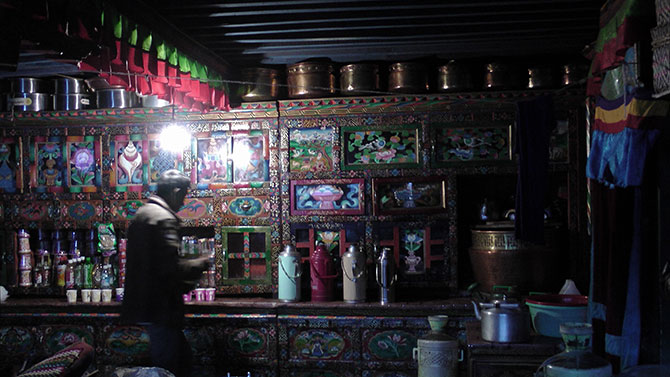 | « Back to article | Print this article |
'The impression I get is bread and butter matters more than freedom and choice. And China is providing bread and butter in plenty.'
Saisuresh Sivaswamy/Rediff.com takes the road less travelled -- to Tibet.
Fifty-five years have elapsed since China annexed Tibet and made the region its own. We in India have a constant reminder of the unpopularity of the armed takeover and the popular will against it in the physical form of the Dalai Lama, Tibet's highest ranking spiritual leader who has remained a consistent opponent of the Chinese decision from his monastery in Dharamsala, Himachal Pradesh.
For 55 years, China has maintained a vice-like grip over the Tibetan Autonomous Region, controlling travel to and from the region. It is not easy to visit Tibet; if you are an Indian, especially a journalist, Tibet is forbidden territory. The only way you can visit Tibet is by lining up for the Kailash-Mansarovar yatra to one of Hinduism's most important pilgrimage points that lies under Chinese control.
Even here, only group visits are allowed, not individual; if you are looking for a Chinese visa to show off on social media on your return, you will be disappointed. There are no entry and exit stamps on your passport.
As I said, group visits are allowed. Like Mahindra Adventure's recent Summit Escape, when India's auto major led a media team to the Everest Base Camp in its SUvs.
As part of the trip, I was able to observe Tibet from inside; conversation was not possible with the locals both owing to language difficulties as well as the instructions to not discuss religion and politics. So what is left, the cold Himalayan weather?

You get a glimpse of what awaits you while spending the night at Tattopani on the Nepal side of the border, waiting for daybreak to initiate the immigration process into Tibet, China. The border village, abutting the pristine Bhote Koshi river that flows down from the tall mountains yonder, is swathed in darkness -- there is no power, despite sitting on a hydro-electric wet dream. So the lilt in your heart on seeing the free Wi-Fi signs is short-lived.
The road is equally dismal, as you figure out in the early-evening darkness. Trucks are haphazardly parked on the side of the road, awaiting the morning's clearance.
And you can see the 'other side,' the first glimpse of Zhangmu town across the border, nestling a little higher in the mountains. Actually you can't miss it, for the town is ablaze with evening lights. Electricity, that is in short supply on the Nepal side, is apparently abundant on the other side.
As you finish the immigration formalities the next morning, held up only on account of the Indian vehicles we were driving into Tibet in, otherwise Chinese efficiency is in display, the difference is stark.
Beyond Zhangmu, some 30 km from the border, where the final inspections are done, the Friendship Highway opens up all the way to Tingri, making the drive a pleasure.

As you whiz past Tibetan enclaves, their pretty facades speeding past in a blur, you catch sight of vehicles parked around, not the comfort ones but practical ones to transport grains and stuff. The pit stop at one of the inspection points for coffee/tea.
It is a house that one has entered, the family's living space which also doubles up as the serving area. Long tables run alongside the walls, rich tapestries hang from the wall, in a corner is the door to the kitchen area, there is a prayer area, rather like an enlarged mandap, in an alcove in the wall, with images of various Buddhist deities, lamas, diyas, prayer flags etc. The family that runs it is Tibetan; the conversation is in Tibetan. There is a television set mounted on the wall.
This is a recurrent motif in the other eateries we halt at, too. They are living spaces cum serving area that the family at once lives in as well as earns from.
So what kind of a life do the Tibetans lead under a Chinese dispensation? Information gleaned from bits of conversation here and there suggests a 'Walk softly but carry a big stick' approach. Tibetans, like everyone else in China, live under State patronage. They are provided easy home loans so mostly everyone owns a house. Education, befitting a communist State, is free, as is healthcare.
"Tell me, you own your house, your children's education is taken care of, the family's healthcare is free, what more can you really want," was a question asked of me.

There is religious freedom as far as I could see. People are left to their own forms of worship, though I did not see a single image of the Dalai Lama who, I am told, still commands enormous respect in Tibet.
Political freedom, which to us coming from a chaotic democracy seems like an article of faith, is absent, but so is it in the rest of China. Freedom of expression/media, which again is something we take for granted, is absent in China. The television we managed to catch would put Doordarshan in its monopolistic heyday when it only sang paeans to the government of the day, to shame.
There was no 'news' on TV; there were feel-good, beatific serials that would outshadow the K series back home.
If you formed a worldview based only on watching Chinese TV that we saw in Tibet, you will grow up believing that all is well in China, as in the rest of the world. People are happy everywhere.

The demographic alteration by importing the Han population into Tibet, I am told, is a feature of Lhasa, not in Shigatse prefecture though which we pass. But there are other forms of Chinese domination.
The language on signboards etc is primarily Chinese, with Tibetan script being secondary, in small letters. TV is in Chinese. And the cuisine is Chinese, too. Finding Tibetan cuisine was a mini challenge. "Why do you want Tibetan food? Eat Chinese," I was told. And Lhasa beer is easily the region's Kingfisher.

There is enormous construction activity going on in Tibet. Roads are being laid, bridges are being built, railway tracks are coming up. All of which generates employment. And, yes, there are solar panels everywhere to harness power free. For despite the Himalayan cold, the sun beats down mercilessly for most parts of the day.
Is there unrest? Ill-will? Unhappiness? Nothing that was visible. And the reason could well be the youth, born much after 1959. They get quality, free education, and jobs after studies, own a car, live well. Don't think Tibet is this arid wasteland you see on the way to the base camp, I was told, Tibet is also Lhasa, which is a developed city like any other.
The impression I get, driving back into Nepal from Tibet five days later, is bread and butter matters more than any abstract construct like freedom and choice. And China, the Asian superpower, is providing bread and butter in plenty.
ALSO READ: